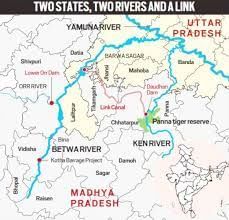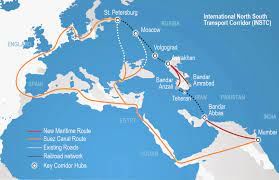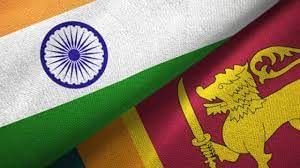UPSC Daily Current Affairs- 20th January 2023 | Current Affairs & Hindu Analysis: Daily, Weekly & Monthly PDF Download
GS-I
Ken-Betwa Link Project

Context
Recently, the Third Meeting of the Steering Committee of the Ken-Betwa Link Project (SC-KBLP) was held under the Chairmanship of the Secretary, DoWR, RD & GR, Ministry of Jal Shakti.
About Ken-Betwa Link Project:
- Under this, the transfer of excess water from the River Ken to the Betwa basin through the use of a concrete canal is proposed.
- It is the first project under the National Perspective Plan for the interlinking of rivers.
- It aims to provide irrigation to the Bundelkhand region, which is one of the worst drought-affected areas in India.
- A Tripartite Memorandum of Understanding was signed between the Centre and the governments of UP and MP for the project.
- Implementing Agency: A Special Purpose Vehicle (SPV) called Ken-Betwa Link Project Authority (KBLPA) will be set up to implement the project.
- The National Interlinking of Rivers Authority (NIRA) has the power to set up SPV for individual link projects.
Source: The Hindu
GS-II
What is International North–South Transport Corridor (INSTC)?
Context
Recently, the Ministry of Ports, Shipping and Waterways, in association with India Ports Global Ltd, conducted a workshop on the ‘Linking Chabahar Port with INSTC’ in Mumbai.
Key facts about International North-South Transport Corridor:
- It is a multimodal transportation agreement formed with a trilateral agreement between India, Iran and Russia at the Euro-Asian Conference on Transport in 2000.
- It links the Indian Ocean to the Caspian Sea via the Persian Gulf onwards into Russia and Northern Europe.
- The corridor encompasses sea, road and rail routes.
- The main purpose of the corridor was to reduce carriage costs and transit time between India and Russia. The transit time is expected to reduce to almost half, once the corridor becomes fully functional.
- The agreement has been ratified by 13 countries namely, Azerbaijan, Belarus, Bulgaria, Armenia, India, Iran, Kazakhstan, Kyrgyzstan, Oman, Russia, Tajikistan, Turkey, and Ukraine.
About Chabahar Port:
- It is located off the Gulf of Oman in Iran’s southeastern province of Sistan-Baluchistan & is the only Iranian port with direct access to the ocean.
Source: Indian Express
India-Sri Lanka relations
Context
External Affairs Minister S. Jaishankar has said that India is committed to increase investment flows to Sri Lanka to hasten its economic recovery
- India and Sri Lankan discussed cooperation in infrastructure, connectivity, energy, industry and health.
- Dr. Jaishankar’s visit to the island nation comes at a crucial time as Sri Lanka has been making efforts to obtain an extended fund facility from International Monetary Fund.
Bilateral Relations:
- India is Sri Lanka’s closest neighbour and the relationship between the two countries is more than 2,500 years old built upon a legacy of intellectual, cultural, religious and linguistic interaction.
- In recent years, the relationship has been marked by close contacts at the highest political level such as Bilateral exchanges at various levels
Political relations:
- Developmental assistance projects for the Internally Displaced Persons (IDPs) and disadvantaged sections of the population in Sri Lanka has helped further cement the bonds of friendship between the two countries.
- During the course of the three-decade long armed conflict between Sri Lankan forces and the LTTE(ended in 2009), India supported the right of the Government of Sri Lanka to act against terrorist forces.
- At the same time, it conveyed at the highest levels its deep concern at the plight of the mostly Tamil civilian population, emphasizing that their rights and welfare should not get enmeshed in hostilities against the LTTE.
- The need for national reconciliation through a political settlement of the ethnic issue has been reiterated by India at the highest levels. India’s consistent position is in favour of a negotiated political settlement, which is acceptable to all communities within the framework of a united Sri Lanka and which is consistent with democracy, pluralism and respect for human rights
- Prime Minister Wickremesinghe has said that India was the ‘only nation’ to help out his country through the continuing food, fuel, and pharma crisis.
Commercial relations:
- India and Sri Lanka signed the India-Sri Lanka Free Trade Agreement (ISFTA) in 1998 which came into force in 2000 – provides duty-free access and duty preferences to goods.
- A Joint Study Group (JSG) was set up in 2003 to make recommendations on how to take the two countries beyond trade and achieve greater economic integration through the conclusion of a Comprehensive Economic Partnership Agreement (CEPA).
- Talks have resumed under a new framework called the ‘Economic and Technological Cooperation Agreement’ (ETCA) – to boost cooperation in technical areas, scientific expertise and research amongst institutions, boost standards of goods and services able to compete on the global market and improve opportunities for manpower training and human resource development.
Trade
- India is Sri Lanka’s largest trading partner with a share of 16 percent in Sri Lanka’s total trade with the world.
- Bilateral trade between India and Sri Lanka has increased by around 9 times between 2000-01 and 2018-19.
- India has always had a trade surplus with Sri Lanka
- In 2018-19, India’s top 3 exports to Sri Lanka included mineral fuels, ships and boats, and vehicles accounting for 43 percent of total exports to Sri Lanka.
- India’s top 3 imports included ships and boats, residues and waste from the food industries, and coffee, tea, mate and spices accounting for 56 percent of total imports.
- India’s exports to Sri Lanka are losing their competitiveness vis-a-vis China’s exports to Sri Lanka.
Development cooperation
- India’s grants to Sri Lanka alone amounting to around USD 570 million, the overall commitment by GOI is to the tune of more than USD 3.5 billion.
- A US$ 100 million LoC for undertaking solar projects in Sri Lanka has been signed between the Government of Sri Lanka and EXIM Bank on June 16, 2021.
- The Indian Housing Project, with an initial commitment to build 50,000 houses in war affected areas and estate workers in the plantation areas, is Government of India (GoI)’s flagship grant project in Sri Lanka.
- The country-wide 1990 Emergency Ambulance Service is another flagship project.
- Some of other notable grant projects which have been completed are the 150-bed Dickoya hospital, livelihood assistance to nearly 70,000 people from fishing and farming community in Hambantota, supply of medical equipment to Vavuniya Hospital and 150 Boats and Fishing gear for Mullaithivu fishermen.
- A modern 1500 – seat auditorium named after Rabindranath Tagore in Ruhuna University, Matara, is the largest in any University in Sri Lanka.
- Under the LOC of USD 318 million, various projects for procurement of rolling stocks for Sri Lankan Railways, upgradation of railway tracks, setting up of railway workshop etc are at different stages of implementation.
Cultural Relations
- The Cultural Cooperation Agreement signed by the Government of India and the Government of Sri Lanka in 1977 forms the basis for periodic Cultural Exchange Programmes between the two countries.
- Buddhism is one of the strongest pillars connecting the two nations and civilizations from the time when the Great Indian Emperor Ashoka sent his children Arhat Mahinda and Theri Sangamitta to spread the teachings of Lord Buddha at the request of King Devanampiya Tissa of Sri Lanka.
- the venerated relics of Lord Buddha from Kapilawasthu discovered in 1970 in India have been exhibited two times in Sri Lanka.
- Prime Minister Shri Narendra Modi during the Virtual Bilateral Summit held between India and Sri Lanka on 26 September 2020, announced a USD 15 million grant assistance for protection and promotion of Buddhist ties between India and Sri Lanka
- In July 2020, the Government of India declared the Kushinagar Airport in India, the place of Lord Buddha’s Mahaparinibbana, as an international airport, to allow Buddhist pilgrims from around the world to visit the revered site associated with Lord Buddha with ease – first inaugural flight from Sri Lanka
- Swami Vivekananda Cultural Centre (SVCC) – the cultural arm of the High Commission of India, Colombo, has been playing a key role in strengthening these ties and promoting people-to-people contacts between India and Sri Lanka since its inception in 1998.
- Tourism – India launched the e-Tourist Visa (eTV) scheme for Sri Lankan tourists in 2015.
Security
- Military exercise called Mitra Shakthi and the Naval exercise called “Slinex.”
- The defence teams from the two nations recently also met at the Colombo Security Conclave (CSC) meet in Kochi, India to further their defence ties.
Issues and concerns
- Traditionally, India–Sri Lanka bilateral relations are centered on a few specific issues and concerns—security concerns (now includes security cooperation), ethnic issues, fishers dispute, and investment climate
- Investment atmosphere – Costly investment agreements had been signed with India, under the Rajapaksa regime, amidst heavy criticism from the political opposition such as in power sector.
- Chinese dominance – Sri Lanka’s balancing act with India, under the shadow of China’s BRI investments in the island to keep both India and China interested has affected Sri Lanka’s relations with India, given the latter’s antithetical relations with China.
- Fisheries front – on daily-basis Indian fishermen continued to be arrested and their boats and gears impounded on allegations of violating the IMBL and poaching in Sri Lankan waters.
- Four Maritime Boundary Agreements have been signed by the two states between 1974-76 regarding the 12 nautical miles of international waters in the Palk Strait, the terms of the agreement are hardly followed diligently.
- The Sri Lankan Navy continues to accuse India’s fishers of violating the decided lines and poaching in their territorial water.
- There is another conflict wherein, Sri Lanka criticizes India’s bottom trawler usage in the Palk Strait, which has been a recurring issue for the countries.
- India’s China concerns viz Sri Lanka continue to remain real though through the past years, there is nothing to suggest that Chinese commercial investments had led to any military/security tie-up that New Delhi should be worried about.
- China-funded Colombo Port City project any time soon looks suspect at best.
- Ethnic issues including the Tamil proposals and the Sinhala-Buddhist majority social reaction
- Till date, the 13th Amendment to Sri Lanka’s Constitution, following the Indo-Sri Lanka Accord, signed on 29 July 1987 has not been honoured.
Way forward
In light of various bilateral issues, the need for national reconciliation through a political settlement of the current issues has been reiterated by India at the highest levels which is consistent with democracy, pluralism and respect for human rights.
Source: Newsonair
Atal Bhujal Yojana

Context
The third meeting of the National Level Steering Committee (NLSC) of the Atal Bhujal Yojana was held at New Delhi under the Chairmanship of Secretary, Department of Water Resources, RD & GR, Ministry of Jal Shakti.
- This scheme is bringing change in Ground Water Management.
Atal Bhujal Yojana (ATAL JAL):
Aim:
- To bring in behavioural changes in the community, from the prevailing attitude of consumption to conservation & smart water management.
- Creation of awareness among the general public about the program objectives
- Creation of an enabling environment for scheme implementation at various levels through information, education and communication (IEC)
- The thrust of the campaign is at the Gram Panchayat(GP) level, where communication tools such as nukkadnataks (street plays), audio-visual clips, wall-writing, display boards, pamphlets and cable TV are being extensively used.
About:
- Central Sector Scheme
- Started in 2020 in 8220 water stressed Gram Panchayats of 229 administrative blocks/Talukas in 80 districts of seven States, viz. Gujarat, Haryana, Karnataka, Madhya Pradesh, Maharashtra, Rajasthan and Uttar Pradesh for five year period (2020-25).
- Interventions include Water Security Plans (WSPs).
- The sustainability of the drinking water sources are to be given utmost priority while taking up interventions under this Scheme.
- Further, since incentive money is an untied fund, it can be used for undertaking pilot projects in any of the Atal Jal Gram Panchayat in order to sustain ground water.
- Since communities are at the forefront in this scheme, importance of capacity building of the communities was also emphasized.
- One of the main challenges was low convergence by the States as compared to what was expected.
Source: PIB
GS-III
Indian Ports Association

Context
Ports, Shipping and Waterways Minister signed the Memorandum of Agreement between the Indian Ports Association and Research and Information System for Developing Countries for setting up a Centre for Maritime Economy and Connectivity in New Delhi.
Indian Ports Association
Aim:
- To make India as one of the major players in world maritime trade, creating the international standards in port operation and utilizing the great potential in our country’s 7517 km long coastline.
- To undertake and promote Techno-Economic Studies and Research into matters pertaining to the Planning Organization
- To offer complete solutions to Port Management and to create a resource of information as a tool for decision making.
- To efficiently promote the use of Work Study, Management Accounting Strategies and other top-of -the-line tools of Management with a view to increase effciency and productivity in ports
- To bring together various national as well as international organisations involved in Port and Harbour Operations, Management and allied activities and to maintain liasion between ports, Ministry of Shipping and other Government agencies.
- To promote the culture of Uniformity and Standardisation in the port functioning.
About:
- The Indian Ports Association(IPA) was constituted in 1966 under Societies Registration Act
- Primarily with the idea of fostering growth and development of all Major Ports.
- IPA is an apex body of Major Ports under the supervisory control of Ministry of Shipping, Government of India.
- Over the years, IPA has consolidated its activities and grown strength by strength and considered to be a think-tank and Centre of Excellence for Indian Maritime Sector.
Source: Newsonair
Ganjam Kewda oil
Context
Families in the coastal pockets of Odisha‘s Ganjam district have been eking out a living by preparing aromatic kewda oil for years, and a recent growth in demand has put a smile on their faces.
- The price per litre of kewda oil was Rs 4.5 lakh last year
- Every year, kewda farmers, flower sellers and oil makers earn around Rs 50-60 crore.
Ganjan kewda oil
- Ganjam kewda (Pandanus fascicularis) oil is steam-distilled from the flower of the aromatic screwpine plant
- Pandanus or screwpine plant grow along seacoasts and in marshy places and forests of tropical and subtropical regions, especially in Asia, Africa, and Oceania.
- It is used as an aromatic in the food industry and other sectors.
- It is registered under the Geographical Indications of Goods (Registration and Protection) Act, 1999 by the Government of India.
- The flower is harvested from around 5,000 hectares in the district.
- Its oil is produced in Ganjam, Chatrapur, Chikiti and Rangeilunda blocks of the district
- For around 200,000 people living in 220 villages of the district, it is the main source of income.
- The farmers and collectors receive an advance from Ganjam’s oil makers who buy the flowers from them during June to September — the harvesting season.
- Kewda oil makers sell to Kannauj, Agra, Kanpur, New Delhi, Mumbai and other places at around Rs 5 lakh a litre
- There is a Fragment and Flavour Development Center (FFDC) extension unit at Berhampore, Ganjam under the Union Ministry of Micro, Small and Medium Enterprises.
- Flower producer groups eliminated the role of middlemen and provided proper marketing facilities.
- FFDC is also training oil makers and helping them purchase modern equipment to start distilling units through the government-managed District Industry Center
- It is used in food, zarda (flavoured tobacco) and pharmaceutical companies
Source: DTE
Spot Bellied Eagle Owl
Context
A wildlife team has recently spotted the ‘Spot Bellied Eagle Owl’ (Bubo Nipalensis) for the first time in the Seshachalam forest, and for the third time in Andhra Pradesh.
About Spot Bellied Eagle Owl:
- It is overall a stark, greyish-brown bird, with dark, coarse brown coloration over the back and upper wings.
- It is a large bird of prey and is also known as the forest eagle-owl.
- It is a very powerful and bold predatory owl.
- The bird makes a strange scream similar to humans and it is hence called the ‘Ghost of the Forest’ in India and ‘Devil Bird’.
- They are mostly found in dense, evergreen forests or moist deciduous forests.
- They are found throughout the Indian subcontinent and peninsular Southeast Asia.
- IUCN Status: Least Concern
- CITES status: Appendix II
Seshachalam Biosphere Reserve:
- Seshachalam Hills are the hill ranges of the Eastern Ghats, southern Andhra Pradesh state, and south-eastern India.
- They are bounded by the Rayalaseema uplands in the west and northwest and the Nandyal Valley (formed by the Kunderu River) in the northeast.
- Minerals contained in these hills include sandstone and shale interbedded with limestone.
- The hills contain seven peaks namely, Anjanadri, Garudadri, Narayanadri, Neeladri, Seshadri, Venkatadri, and Vrishabhadri.
- It was designated as a Biosphere Reserve in 2010.
- Tirupati, a major Hindu pilgrimage town and the Sri Venkateshwara National Park are located in these ranges.
- It is home to a number of endemic species including the famous Red Sanders and Slender Loris.
- Tribes of Yanadis are the native population of the reserve.
Source: The Hindu
|
52 videos|5374 docs|1136 tests
|
FAQs on UPSC Daily Current Affairs- 20th January 2023 - Current Affairs & Hindu Analysis: Daily, Weekly & Monthly
| 1. What is the significance of GS-I in the UPSC exam? |  |
| 2. What topics are covered under GS-II in the UPSC exam? |  |
| 3. What are the key areas of study in GS-III for the UPSC exam? |  |
| 4. What is the importance of daily current affairs in the UPSC exam preparation? |  |
| 5. How can one effectively prepare for the UPSC exam's general studies papers? |  |




















